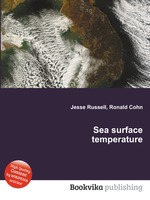Sea surface temperature
Jesse Russell Ronald Cohn
бумажная книга
High Quality Content by WIKIPEDIA articles! Sea surface temperature (SST) is the water temperature close to the oceans surface. The exact meaning of surface varies according to the measurement method used, but it is between 1 millimetre (0.04 in) and 20 metres (70 ft) below the sea surface. Air masses in the Earth`s atmosphere are highly modified by sea surface temperatures within a short distance of the shore. Localized areas of heavy snow can form in bands downwind of warm water bodies within an otherwise cold air mass. Warm sea surface temperatures are known to be a cause of tropical cyclogenesis over the Earth`s oceans. Tropical cyclones can also cause a cool wake, due to turbulent mixing of the upper 30 metres (100 ft) of the ocean. SST changes diurnally, like the air above it, but to a lesser degree due to its higher specific heat. There is less SST variation on breezy days than on calm days. In addition, ocean currents and the global thermohaline circulation affect average SST significantly throughout most of the world`s oceans. For SSTs near the fringe of a landmass, offshore winds cause upwelling, which can cause significant cooling, but shallower waters over a continental shelf are often warmer. Onshore winds can cause a considerable warm-up even in areas where upwelling is fairly constant, such as the northwest coast of South America. Its values are important within numerical weather prediction as the SST influences the atmosphere above, such as in the formation of sea breezes and sea fog. It is also used to calibrate measurements from weather satellites.


